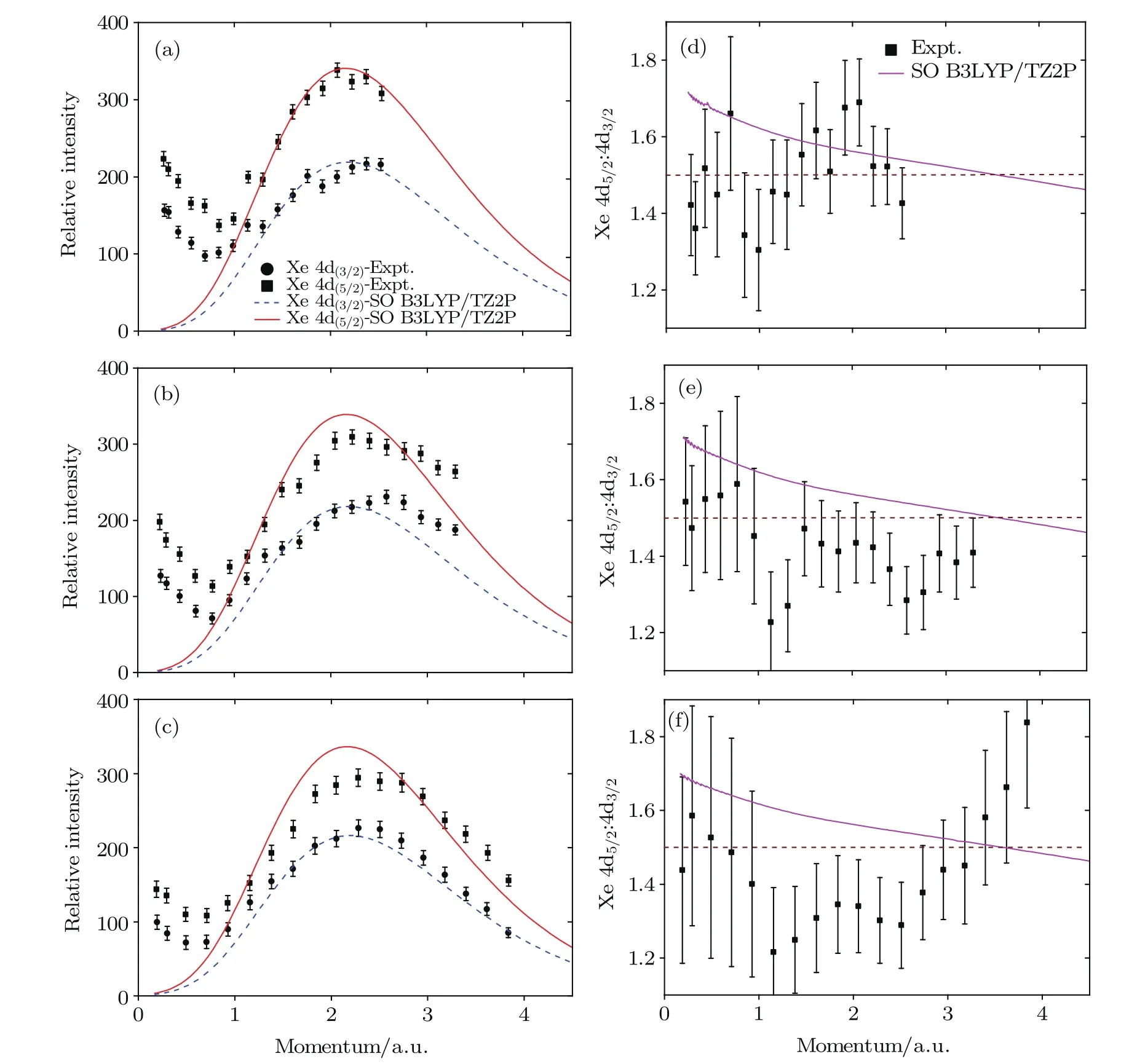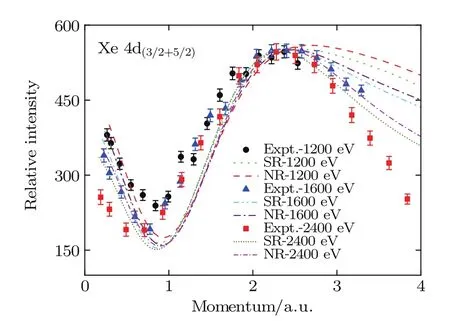Relativistic and distorted wave effects on Xe 4d electron momentum distributions?
Minfu Zhao(趙敏福),Xu Shan(單旭),Shanshan Niu(牛姍姍),and Xiangjun Chen(陳向軍)
1 Department of Experiment and Practical Training Management,West Anhui University,Lu’an 237012,China
2 Hefei National Laboratory for Physical Sciences at the Microscale and Department of Modern Physics,University of Science and Technology of China, Hefei 230026,China
Relativistic and distorted wave effects on Xe 4d electron momentum distributions?
Minfu Zhao(趙敏福)1,2,?,Xu Shan(單旭)2,Shanshan Niu(牛姍姍)2,and Xiangjun Chen(陳向軍)2
1 Department of Experiment and Practical Training Management,West Anhui University,Lu’an 237012,China
2 Hefei National Laboratory for Physical Sciences at the Microscale and Department of Modern Physics,University of Science and Technology of China, Hefei 230026,China
The relativistic and distorted wave effects are investigated for the electron momentum distributions of Xe 4d electrons. The theoretical results show good agreements with the experimental data measured previously with electron momentum spectroscopy.The distorted wave effect and the relativistic effect are found to play important roles in the low and high momentum regions,respectively.
relativistic effect,distorted wave effect,electron momentum distributions
1.Introduction
Relativistic effects of high-Z atoms and molecules containing high-Z atoms have been attracting a great deal of research interest.[1–15]The relativistic effects can be divided into a direct relativistic effect and an indirect relativistic effect.[3]The direct relativistic effect includes kinematical and spin–orbit coupling effects.The kinematical one is caused by electrons moving with high speeds near the heavy nucleus,which results in the spatial contractions of orbits s and p and the energy loses.The spin–orbit(SO)coupling effect is a result of interaction between the electron’s spin magnetic and orbit moments,leading to the energy-level splitting.The indirect relativistic effect refers to the contraction caused by the inner orbit which can block the heavy nuclear more severely,leading to the outer orbits d and f expanding in the location space and improving the energy.
Photoelectron spectroscopy,nuclear magnetic resonance (NMR),and Compton scattering are the basic experimental methods to explore the relativistic effects.On the other hand, electron momentum spectroscopy(EMS)has its unique advantages in the study of the relativistic effects,which can show the relativistic effects not only on the ionization energies but also on the orbital wave functions of a heavy atom via the measurements of electron momentum distribution.This is particularly true for xenon,for which a significant number of electron momentum spectroscopy studies(Leung and Brion,[4]Cook et a1.,[5,6]Braidwood et al.,[7]Brunger et al.,[8]Brion et al.,[9]Ren et al.[10])and photoelectron spectroscopy(PES)measurements(Gelius,[11]Svensson et al.,[12]Krause et al.[13])have been carried out.The PES works of Gelius[11]and Svensson et a1.[12]have examined these core states in detail;the importance of these studies lies in their accurate determination of the binding energies of the 4d5/2and 4d3/2states.
In 1984,Cook et al.[5,6]for the first time studied the relativistic effects on the outermost layer of the Xe atom’s 5p orbital in view of the wave function by the EMS technique.Due to the poor energy resolution(~1.6 eV)of their spectrometer, the SO splitting bands(with an energy spread~1.3 eV)about the ionization of Xe 5p orbital could not be resolved clearly; the electron momentum distributions and the branching ratio of two splitting components 5p3/2and 5p1/2were obtained by the spectral deconvolutions.[5,6]In 1994,Brunger et al.[8]reported the momentum distribution about Xe 4d electrons.Although they observed peak splitting(with an energy spread~1.97 eV)between 4d5/2and 4d3/2states,they did not find the difference of SO coupling effects on the electron momentum distributions of these two states.In 1998,Brion et al.[9]reported,using the EMS technique,the distorted wave effect on the low momentum distribution region of Xe 4d electrons, but they did not go into the details of the SO coupling effect. In 2006,using the EMS spectrometer with an energy spread of 1.2 eV,Ren et al.measured the electron momentum distributions of the SO splitting components 4d5/2and 4d3/2of Xe and found the variations of the branch ratio between these two components with the change of the incident electron energy(E0=1200 eV,1600 eV,2400 eV).[10]Their observations were explained with a combination of the distorted wave effect and the relativistic effect,but they did not identify the different roles of these two effects.[10]
In this paper,we calculate the wave function of Xe 4d5/2and 4d3/2with the relativistic density functional theory (RDFT),then obtain the electron momentum distributions ofthe two components of Xe 4d5/2and 4d3/2electrons and the branch ratios of the angular-resolved differential cross section. In comparison to the low region of the electron momentum distributions between the experimental[10]and theoretical results, the distorted wave Born approximation(DWBA)is used because of the well-known distorted wave effect on the 4d electron.
2.Theoretical calculation
(e,2e)as a single-collision ionization process can be studied with EMS,which is a kinematical complete measurement technique.Completely observed quantity of this reaction is a triple differential scattering cross section(TDCS),which is expressed in atomic unit as[16,17]

Under the distorted wave Born approximation(DWBA), the ionization amplitude is expressed as follows:[18]

where ψiis the wave function of the target’s initial state bound electron which can be taken from the Hartree–Fock wave function of Clementi and Roetti’s article.χ(+)(k0)is the distorted wave function of the incident electron,and(j=1, 2)is the distorted wave function of the outgoing electron.The corresponding triple differential crosssection can be expressed as[19]

When calculating the distorted wave with partial wave method,we adopt equivalent local central potential V00(r)to represent the distorting effect of the electron.The equivalent local basic potential V00(r)=VD(r)+VE(r),in which direct potential VD(r)is[20]

where Nnlis the electron occupation number of orbital nl,and r>is the larger one of r and r′.Exchange potential VE(r)takes the modified semi-classical exchange potential(MSCEP)[21]


where E is the system energy,and ρ(r)is the electron density.
In the case that the impact energy is larger(E0>20εf), the plane wave impulse approximation(PWIA)is applicable and thus the triple differential cross section is[17,18,22]


For the heavy element atoms or molecules containing heavy elements,relativistic effects have an obvious impact on the wave function,we need to use the theory of relativity quantum chemical method to calculate it.The scalar relativistic (SR)method is used here for treating the relativistic effect on Xe 4d electrons.The theoretical calculations are performed with the density functional program ADF.[24,25]The B3LYP density functional and the relativity ZORT[26]/TZ2P basis set are adopted in the calculations.The distorted wave effect is considered by using the distorted wave program with the DWBA method[27]and the SR wave functions obtained in the above B3LYP calculations.Non-relativistic(NR)calculations based on Eq.(7)are also carried out for comparison.
3.Results and discussion
The theoretical electron momentum distributions of Xe 4d5/2and 4d3/2are shown in Figs.1(a)–1(c)and compared with the experimental ones obtained at the impact energy E0=1200 eV,1600 eV,and 2400 eV.[10]The resolution due to Δθ=0.7°and Δ?=1.9°[10]is considered in the normalization of the theoretical momentum distributions.In the high momentum region(>1.0 a.u.),the theoretical and experimental distributions match very well;but distinct differences can be found in the low momentum region(<1.0 a.u.).As proposed before,the obvious turn-up distributions are caused by the distorted wave effect.[9]Figures 1(d)–1(f)present the cross-section ratios for the 4d5/2and 4d3/2electrons.The wave functions having the same quantum numbers n andlbut different total angular momentum j(which is related to the relativistic effect)are different,[5]as shown in Figs.1(d)–1(f), the ratios vary with the electron momentum.Although the theoretical ratios predict the similar tendency of the experimental data,the discrepancies are obvious and further theoretical calculations at the higher level are needed.

Fig.1.We use the relativistic density functional method to calculate the xenon atoms 4d5/2,4d3/2 orbital of electron momentum distribution and xenon atoms 4d5/2:4d3/2 the relationship between the ratio of scattering cross section and momentum,choosing the relativity ZORT/TZ2P base group.Panels(a),(d);(b),(e);and(c),(f)are experimental values of impact energies of 1200 eV,1600 eV,and 2400 eV.The experimental data are taken from Ref.[10].

Fig.2.Electron momentum distribution of Xe 4d orbital with DWBA calculation.NR uses the Clementi basis function,and SR uses the basis function obtained by scalar relativistic B3LYP/TZ2P.The solid dot, triangle,and the square are experimental values of the impact energies of 1200 eV,1600 eV and 2400 eV,respectively.[10]
To further elucidate the distorted wave effect,in particular,in the low electron momentum region,the experimental momentum profiles by summation of two SO splitting components are compared with the NR and SR theoretical results in Fig.2.The dynamic influences arising from the different impact energies(E0=1200 eV,1600 eV,and 2400 eV)indicate the weakening of the distorted wave effect with the increase of the impact energy.In Fig.2,both NR and SR theoretical results can give a good description of the distorted wave effect in the low momentum region,but there are some overestimations at the high momentum region.In comparison with the NR distributions,the SR ones are a little lower and closer to the experimental data in the high momentum region.As pointed out before in this paper,the larger discrepancies between the theoretical and experimental data in the high momentum region are largely due to the stronger relativistic effect.
4.Conclusion
The electron momentum distributions of Xe 4d electrons are investigated theoretically by considering the relativistic and distorted wave effects,and compared with the EMS experimental data recorded at different impact energies.[10]The distorted wave effect is significant in the low momentum regions of both spin–orbit splitting 4d5/2and 4d3/2ionization states,while the relativistic effect is remarkable in the high momentum regions.
[1]Pyykk? P 1988 Chem.Rev.88 563
[2]Reiher M and Hess B A 2000 Modern Methods and Algorithms of Quantum Chemistry(Jülich:Jülich Research Center)
[3]Liu W J 2007 Progress in Chem.19 833
[4]Leung K T and Brion C E 1983 Chpm Phys.82 87
[5]Cook J P D,Mitroy J and Weigold E 1984 Phys.Rev.Lett.52 1116
[6]Cook J P D,McCarthy I E,Mitroy J and Weigold E 1986 Phys.Rev.A 33 211
[7]Braidwood S,Brunger M J and Weigold E 1993 Phys.Rev.A 47 2927
[8]Brunger M J,Braidwood S W,McCarthy I E and Weigold E 1994 J. Phys.B 27 L597
[9]Brion C E,Zheng Y,Rolke J and Neville J J 1998 J.Phys.B 31 L223
[10]Ren X G,Ning C G and Deng J K 2006 Phys.Rev.A 73 042714
[11]Gelius U 1974 J.Electron Sgeetrose.5 984
[12]Svensson S,Erikson B,Martensson N,Wendin G and Gelius U 1988 J. Electron.Spectrosc.47 327
[13]Krause M O,Whitfield S B,Caldwell C D,Wu J Z,van der Meulen P, de Lange C A and Hansen R W C 1992 J.Electron.Spectrosc.58 79
[14]Chen X J,Li Z J and Shan X 2008 Physics 37 576
[15]Liu K,Ning C G and Deng J K 2010 Chin.Phys.Lett.27 73403
[16]Brion C E 1986 Int.J.Quantum Chem.29 1397
[17]McCarthy I E and Weigold E 1991 Rep.Prog.Phys.54 789
[18]McCarthy I E and Weigold E 1976 Phys.Rep.27 275
[19]Zhang X,Whelan C T,Walters H R J,Allan R J,Bickert P,Hink W and Sch?nberger S 1992 J.Phys.B:At.Mol.Opt.Phys.25 4325
[20]Khajuria Y,Chen L Q and Chen X J 2002 Phys.Rev.A 65 042706
[21]Gianturco F A and SCialla S 1987 J.Phys.B:At.Mol.Phys.20 3171
[22]Weigold E and McCarthy I E 1999(New York:Kulwer Academic/Plenum Publishers)
[23]Duffy P,Chong D P and Casida M E 1994 Phys.Rev.A 50 4707
[24]Guerra C F,Snijders J G,te Velde G and Baerends E J 1998 Theor. Chem.Acc.99 391
[25]Velde G T,Bickelhaupt F M,Baerends E J,Guerra C F,Van Gisbergen S J A,Snijders J G and Ziegler T 2001 J.Comput.Chem.22 931
[26]Vanlenthe E,Baerends E and Snijders J 1994 J.Chem.Phys.101 9783
[27]McCarthy I E and Weigold 1988 Rep.Prog.Phys.51 301
14 April 2017;revised manuscript
23 May 2017;published online 18 July 2017)
10.1088/1674-1056/26/9/093103
?Project supported by the National Natural Science Foundation of China(Grant Nos.11327404 and U1432118)and the Natural Science Research Programme of Education Department of Anhui Province,China(Grant Nos.KJ2013A260 and KJ2016A749).
?Corresponding author.E-mail:zhaomf@wxc.edu.cn
?2017 Chinese Physical Society and IOP Publishing Ltd http://iopscience.iop.org/cpb http://cpb.iphy.ac.cn
- Chinese Physics B的其它文章
- Relationship measurement between ac-Stark shift of 40Ca+clock transition and laser polarization direction?
- Air breakdown induced by the microwave with two mutually orthogonal and heterophase electric field components?
- Collective motion of active particles in environmental noise?
- Temperature dependence of heat conduction coefficient in nanotube/nanowire networks?
- Analysis of dynamic features in intersecting pedestrian flows?
- Heat transfer enhancement in MOSFET mounted on different FR4 substrates by thermal transient measurement?

